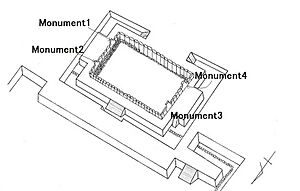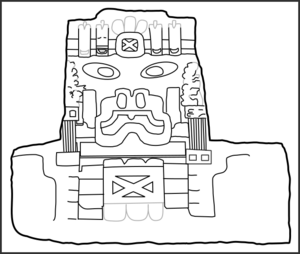Teopantecuanitlan facts for kids
Teopantecuanitlan is an ancient place in the Mexican state of Guerrero. It shows that complex societies started much earlier in this area than people first thought. This site dates back to the Early to Middle Formative Periods, which was a long time ago!
Archaeologists have found signs that Teopantecuanitlan had some kind of connection with the Olmec people, who lived far away on the Gulf Coast. Before Teopantecuanitlan was discovered in the early 1980s, not much was known about how societies developed in this region during that ancient time.
Contents
Where is Teopantecuanitlan?
Teopantecuanitlan is located in the state of Guerrero, Mexico. It's about 20 kilometers (12 miles) southwest of a town called Copalillo. The closest village is Tlalcozotitlan.
The site sits where the Amacuzac and Balsas rivers meet. This was a great spot for trade and travel in ancient times. Teopantecuanitlan covers a large area, about 1.6 to 2 square kilometers (500 acres). It's at the bottom of a steep hill that rises 200 meters (656 feet) above the site.
Teopantecuanitlan was an important center for the surrounding region. Other nearby ancient places included Oxtotitlán, Juxtlahuaca, Xochipala, Zumpango del Río, and Chilpancingo.
Life in Ancient Teopantecuanitlan
People lived in Teopantecuanitlan from about 1400 to 500 BCE (Before Common Era). The site was most active and had the most people between 1000 and 800 BCE.
Most homes were built in groups of four structures around a shared courtyard or open space. The buildings themselves were made of materials that would decay over time, like wood or thatch, but they had strong stone foundations.
Archaeologists found special items here, such as imported shells and obsidian (a type of volcanic glass). They also found pottery that showed influence from the Olmec people. These discoveries tell us that Teopantecuanitlan was part of a big trade network. This network connected the Gulf Coast with the highlands of Central Mexico.
Some ancient clay sculptures were found north of the Sunken Patio. These are the oldest sculptures at the site.
The Sunken Patio: El Recinto
Teopantecuanitlan is famous for its amazing buildings and art. One of the most important structures is called El Recinto, also known as the Sunken Patio. It was built between 1000 and 800 BCE. This was one of the first special public buildings in all of Mesoamerica.
It's called the Sunken Patio because it's built 2 meters (7 feet) below the natural ground level. It has a base of yellow clay and is covered with smooth travertine stone blocks.
Four large, almost identical stone blocks decorate the east and west sides of the Sunken Patio. These blocks are carved to look like powerful jaguar-like creatures. They have almond-shaped eyes and mouths that turn downwards. These huge stones weigh between 3 and 5 tons!
The name Teopantecuanitlan means "place of the temple of the jaguar" in the Nahuatl language. This name was given by archaeologist Guadalupe Martinez Donjuán because of these jaguar sculptures. She believes these sculptures were placed to mark the equinoxes or solstices (special times of the year related to the sun). They might have represented opposing forces in the world.
On the back of one of these monuments, called Monument 2, there are symbols. Martinez Donjuán thinks these symbols mean "10 Flower." If this is true, it would be the oldest Mesoamerican calendar date ever found!
The site also has two Mesoamerican ballcourts. One small ballcourt is inside the Sunken Patio. Another larger one is about 900 meters (half a mile) to the northeast. Near the smaller ballcourt, there's an adobe sweat bath. This sweat bath was probably used by the important people of Teopantecuanitlan to socialize.
Smart Engineering and Society
Teopantecuanitlan is home to the oldest known dam in Mesoamerica. This dam was built around 1200 BCE using rough, uncut rocks. It used gravity to bring water to the farming fields.
There are also canals, or channels, made of large flat stone slabs. These canals helped with irrigation, bringing water to plants. They also prevented soil erosion and acted like a sewer system.
This site is also the first in Mesoamerica known to use a special building technique called a corbelled vault. This allowed builders to create high ceilings without using specially cut trapezoid stones. These vaults were used in important buildings like tombs for leaders and temples.
The society at Teopantecuanitlan was not equal. There were leaders who planned and oversaw the building of these huge structures. They directed the workers and made sure all the materials were available.
How Teopantecuanitlan Was Found
Teopantecuanitlan was discovered in 1983 by archaeologist Guadalupe Martinez Donjuán. She found it after hearing reports of people illegally digging for artifacts at the site. Christine Niederberger helped with the discovery, focusing on the residential areas.
Today, the Teopantecuanitlan site is open for visitors! You can visit Tuesdays through Sundays from 10:00 AM to 5:00 PM.
Connections to the Olmec People
Many of the monuments and artifacts at Teopantecuanitlan show the influence of the Olmec people. This is especially true for the four large jaguar-like monuments at the Sunken Patio.
Scientists have different ideas about how Olmec designs and ideas came to a place hundreds of miles away from the Olmec heartland (their main area).
One idea, from Martinez Donjuán, is that the Olmec culture actually started in Teopantecuanitlan. She thinks a group of people left Teopantecuanitlan and moved to the area we now call the Olmec heartland. This idea was first suggested by Miguel Covarrubias in 1946.
The state of Guerrero seems to have been very important in the early history of Olmec culture. Some Olmec-style objects found in Guerrero are even older than those found in the main Olmec area. For example, items from the Amuco-Abelino site in Guerrero date back to 1530 BCE.
However, other archaeologists, like Michael D. Coe, disagree. They point out that the dry highlands of Guerrero would have been a difficult place for the Olmec culture to begin. Christine Niederberger believes that only the big monuments show Olmec influence, while the rest of Teopantecuanitlan's culture came from the local people.
Images for kids
See also
 In Spanish: Teopantecuanitlán para niños
In Spanish: Teopantecuanitlán para niños




